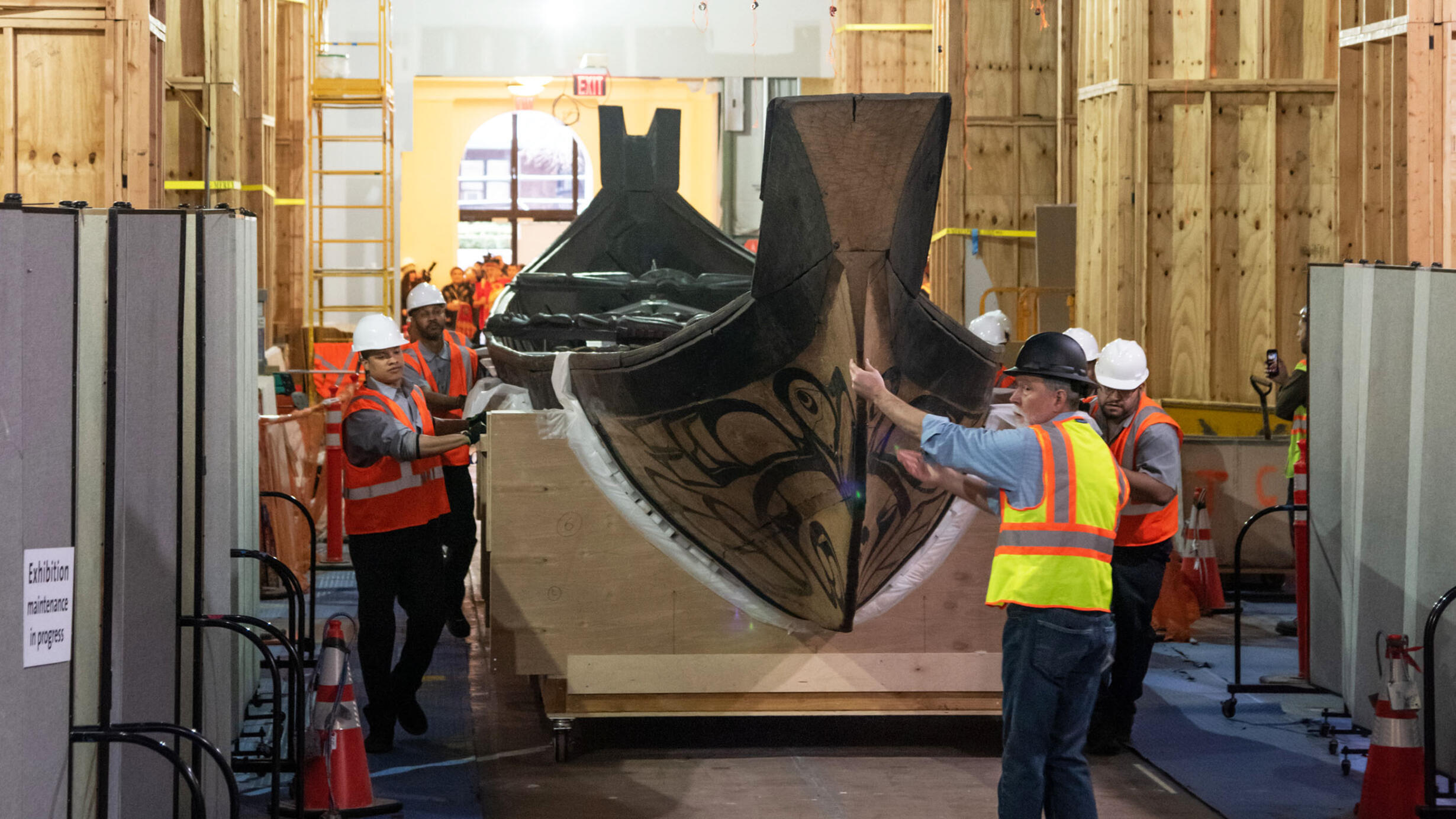 On January 28, 2020, the American Museum of Natural History relocated the iconic 63-foot Great Canoe from the Grand Gallery to the Northwest Coast Hall.
On January 28, 2020, the American Museum of Natural History relocated the iconic 63-foot Great Canoe from the Grand Gallery to the Northwest Coast Hall.D. Finnin/© AMNH
The iconic 63-foot Great Canoe was moved this week from the Museum’s Grand Gallery into the Northwest Coast Hall, which is undergoing a major restoration and will reopen in 2021.
One of the largest dugout canoes in existence, the Great Canoe was carved from a single Western red cedar tree in the 19th century and shows design elements from both the Heiltsuk and Haida Nations of the Pacific Northwest Coast. The canoe first arrived in New York in 1883, after a journey by sea, rail, and horse and has been displayed in several locations. In the 1880s, it was suspended from the ceiling of what is now the Leonard C. Sanford Hall of North American Birds, and later in the Ethnological Hall, which opened as the Northwest Coast Hall in 1899. In 1960, the canoe was moved to the 77th Street foyer, now the Grand Gallery, and displayed at floor level. After undergoing extensive restoration in 2006, including the removal of the figures, the roughly 2,200-pound canoe was once again suspended from the ceiling.
M. Shanley/© AMNH
As the Great Canoe was moved into the Northwest Coast Hall, Curator Peter Whiteley was joined by Haa’yuups (Ron Hamilton), Nuu-chah-nulth artist and cultural historian who is co-curating the Northwest Coast Hall restoration project, as well as by Jisgang (Nika Collison, Haida Nation, Ts’aahl clan; director of the Haida Gwaii Museum at Kay Llnagaay), Chief Wigviłba Wákas (Harvey Humchitt, Heiltsuk, community leader), and Kaa-xoo-auxch (Garfield George, head of the Raven Beaver House of Angoon/Dei Shu Hit “End of the Trail House,” Tlingit), three project advisors from a core group that includes Native scholars, artists, and other authorities from Alaska, Washington State, and British Columbia, and by Megan Humchitt, council member at Heiltsuk Tribal Council, Waglisla, in British Columbia and daughter of Chief Wigviłba Wákas.
Before the move, Jisgang, Chief Wigviłba Wákas, Kaa-xoo-auxch, and Megan Humchitt walked around the canoe, touching it gently and blowing eagle down while Haa’yuups sang “a call to our ancestors to thank them for creating this beautiful thing.”
M. Shanley/© AMNH
Canoes have been at the center of Northwest Coast life for centuries, with a long history of canoe making and of canoe exchanges between nations. “Canoes are absolutely essential to all of the people represented here today,” said Haa’yuups. “All of our people made a living not long ago in and out of the sea. My people were whalers … From birth to death, people lived in canoes.”
Whiteley said the relocation of the canoe was an important piece in the ongoing project to update, restore, and conserve the historic Northwest Coast Hall—the Museum’s first hall and first cultural gallery.
“In renovating this hall, we want to honor the perspectives and interests of the people who made these objects, working with Haa’yuups and 10 key advisors,” he said.
Jisgang spoke of how canoes have connected people within and between the First Nations, and how the Museum’s restoration project of the Northwest Coast Hall will serve that purpose, too.
“We’re putting ourselves back together,” she said. “We’re putting our treasures back together. That’s exciting.”
The Great Canoe will return to view when the Northwest Coast Hall reopens in 2021, featuring new interpretation developed in collaboration with Native advisors.